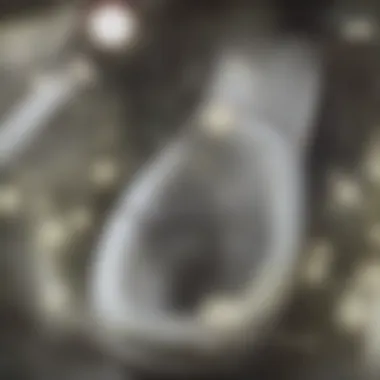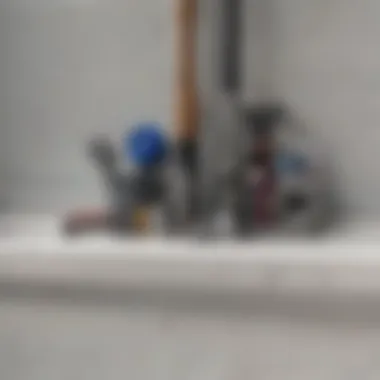Unclogging a Toilet Drain: Methods & Techniques


Intro
Dealing with a clogged toilet drain is an unpleasant experience that can disrupt daily life. Understanding the methods and techniques available for unclogging a toilet can empower homeowners and renters alike. Whether the issue arises from simple blockages or more complex plumbing problems, knowing how to approach the situation can save time and frustration. In this article, we will explore various strategies, from household remedies to professional interventions, ensuring that readers have the knowledge required to maintain their plumbing effectively.
Feature Spotlight
In the realm of plumbing, having an understanding of effective tools and techniques can make all the difference in resolving drainage issues. The most common feature in addressing toilet clogs is the plunger. It is simple yet effective for clearing moderate blockages. However, there are specialized plungers designed specifically for toilets, offering better suction and ergonomics.
Another tool worth noting is the toilet auger, commonly referred to as a plumbing snake. This tool can reach deeper blockages that a simple plunger may not be able to affect. It consists of a long, flexible cable with a coiled end that lets you break up or remove the clog effortlessly.
"Understanding the tools can transform a frustrating experience into a manageable task."
Having these tools on hand plays a vital role in effective toilet maintenance. It prevents future clogs and enhances the overall function of one of the most essential fixtures in any home.
Common Drainage Issues
The issues that cause toilet clogs can primarily be categorized into two types: physical blockages and functional problems.
- Physical blockages may involve items like sanitary products or excessive toilet paper.
- Functional problems might include issues with the plumbing vent or sewer line, requiring more extensive repairs.
Understanding these problems helps identify the right approach for unclogging the toilet effectively.
Techniques for Unclogging
When it comes to the actual unclogging process, several techniques can be employed based on the severity of the blockage. Here are some practical methods:
- Plunge the Toilet: Start with a toilet plunger. Ensure there is enough water in the bowl to cover the plunger's cup. Use rapid, forceful thrusts to create suction and push the clog back into the drain.
- Use a Toilet Auger: If plunging fails, a toilet auger can help reach deeper clogs. Insert the auger into the toilet, turning the handle to advance the cable into the drain.
- Wet/Dry Vacuum: For more stubborn blockages, employing a wet/dry vacuum can assist in removing the clog. Adjust the vacuum to liquid mode and create a seal around the toilet bowl, allowing suction to pull the obstruction out.
By employing these techniques properly, one can effectively restore the function of the toilet without relying solely on harsh chemicals.
Preventive Measures
To minimize the chances of future clogs, it is wise to follow preventative measures. Consider these guidelines:
- Limit what goes into the toilet: Only flush human waste and toilet paper.
- Regular Maintenance: Periodically check for issues with flushing and drainage.
- Educate Household Members: Ensure everyone understands proper flushing habits.
Adhering to these practices can significantly reduce the likelihood of encountering clogs in the future, saving both time and expense.
Preface to Toilet Clogs
Toilet clogs are a regular household issue that can disrupt daily life. Understanding how toilets function and the common reasons behind blockages can help in addressing these problems effectively. This section aims to provide insights into the mechanisms of toilet drains and the frequent causes of clogs. By grasping these fundamentals, one can better determine appropriate strategies for prevention and resolution.
Understanding Toilet Functionality
Toilets operate on a straightforward principle. When you flush, water from the tank rushes into the bowl, forcing waste and water down the drain. Different toilet designs may vary slightly, but the core mechanics remain similar. The water level must be enough to create a sufficient seal in the trap, preventing unwanted odors from escaping. This balance of pressure and water flow is crucial. If either is disrupted, you may experience problems.


These fundamentals become particularly relevant when dealing with clogs. An understanding of how your toilet works can empower you to troubleshoot issues more effectively. Simple observations might alert you to potential problems before they escalate. Pay attention to sounds, water levels, and flushing behavior as they all provide clues regarding your toilet's health.
Common Causes of Toilet Clogs
Several factors can contribute to toilet clogs. Knowing these can enhance your awareness and efforts in maintaining an efficient system.
Typical causes include:
- Excessive waste: Often, overloading the toilet with toilet paper or other non-flushable items leads to blockages.
- Foreign objects: Items accidentally dropped in the toilet, such as toys or hygiene products, can easily obstruct the drain.
- Tree roots: In some scenarios, roots from trees can infiltrate sewer lines, causing significant backups.
- Poor installation: Improper installation of pipes can lead to slow drainage and clogs over time.
Clogs may begin as minor inconveniences. Yet, neglecting early signs can lead to more significant plumbing difficulties later. Staying proactive about maintenance can save time and money in the long run.
Identifying the Symptoms of a Clogged Toilet
Understanding how to identify the symptoms of a clogged toilet is vital for any homeowner or renter. Early detection can save time and prevent more severe plumbing issues. Recognizing signs of a clog allows for prompt action before it escalates into a major problem. Beyond avoiding unpleasant situations, knowing these symptoms can help maintain your plumbing system’s efficiency, potentially extending its lifespan.
Signs of an Impending Clog
To prevent a toilet disaster, it's essential to be aware of the initial indicators that a clog is developing. Some common signs include:
- Slow Draining: If the toilet takes longer than usual to empty, this could signal an impending clog.
- Gurgling Noises: Unusual sounds from the toilet, especially after flushing, can indicate that air is trapped in the pipes due to a blockage.
- Frequent Backups: If your toilet is frequently backing up, especially if accompanied by water rising near the rim, immediate attention is warranted.
- Unusual Odors: Foul smells emanating from the toilet area may suggest stagnant water and waste accumulating, pointing toward a blockage.
Addressing these signs early can save you considerable time and money.
Assessing Water Levels and Flushing Problems
Evaluating toilet water levels and understanding flushing mechanisms are critical steps in diagnosing a clog. Begin by observing the water level in the bowl. A toilet that consistently has low water levels may indicate an obstruction in the drain line or a problem with the fill valve.
- Water Levels: Normal water levels sit just below the rim of the bowl. If you notice an irregular level, further investigation is needed.
- Flushing Difficulty: If you experience difficulty flushing, where the water does not swirl around as it should or requires repeated attempts to work, this could be a sign of a developing clog.
- Partial Flushes: If flushing leads to partial evacuations, this can indicate a blockage that stops waste from flowing freely down the pipes.
In summary, keen observation of your toilet's behavior can help identify clogs before they escalate into more significant concerns.
Essential Tools for Unclogging
Unclogging a toilet effectively often requires the right tools. Having essential tools at hand not only speeds up the process but also improves the chances of successfully clearing the blockage without causing further damage. Each tool serves a specific purpose and can make a noticeable difference in tackling various types of clogs. The importance of understanding these tools cannot be overstated, especially for homeowners and renters who face plumbing issues regularly. Equipping oneself with the appropriate implement ensures that an individual can respond promptly and efficiently when needed.
Plunger: Selecting the Right Type
The plunger is often seen as the first line of defense against toilet clogs. However, not all plungers are created equal. The most common types are the flange plunger and the cup plunger. The flange plunger features a rubber flange that extends from the bottom, which is designed for toilets, ensuring a better seal and more effective pressure application. When selecting a plunger, consider its build quality and suction capability. A sturdy handle and a well-formed rubber cup are vital. Using the right plunger can facilitate a more efficient attempt at unclogging, making it essential to invest in a quality tool.
Drain Snake and Auger: How They Work
Drain snakes, also known as augers, play a crucial role in dealing with tougher clogs. These tools consist of a long, flexible metal cable with a coiled end. The primary function is to reach deep into the toilet drain to break up obstructions or snag debris that is too stubborn for a plunger. To use one, insert the snake into the toilet drain until resistance is felt. Rotating the handle allows the coil to penetrate the clog. Understand that while using an auger, patience is key. With gentle but firm pressure, one can often clear blockages that cause significant trouble. Their effectiveness and adaptability for both toilet and sink drains make them an essential tool.
Using Chemical Drain Cleaners: Risks and Benefits


Chemical drain cleaners can be a tempting option due to their convenience. These products can dissolve certain types of clogs quickly. However, they come with significant risks that must be considered. Many chemical cleaners contain harsh substances that can damage pipes or harm plumbing fixtures if not used correctly. Over time, such chemicals may contribute to corrosion, leading to more severe plumbing issues down the line. On the other hand, there are benefits; these cleaners usually work fast on dissolving organic waste. It’s crucial to read labels and instructions carefully. When opting for chemical solutions, one must weigh the potential benefits against the risks to the plumbing system.
Conclusion: Having the right tools is critical for efficiently tackling toilet clogs. Understanding the uses and limitations of each tool ensures that you can handle potential plumbing problems effectively and safely.
Step-by-Step Guide to Unclogging a Toilet
Unclogging a toilet is a necessary skill that every household should master. Understanding the step-by-step process not only empowers individuals to address minor clogs themselves but also minimizes the need for professional assistance. Knowing how to correctly handle a clogged toilet helps in saving time and reducing frustration. It also contributes to maintaining the health of your plumbing system by preventing potential damage caused by prolonged clogs. This guidance is geared toward both inexperienced homeowners and individuals seeking a systematic approach to bathroom maintenance, ensuring clarity and efficiency.
Preparing the Area: Safety Precautions
Before tackling a clogged toilet, it is crucial to prepare the area. Begin by gathering the necessary tools, including a plunger, gloves, and towels. Ensure you have protective gear, as working with a clogged toilet often involves exposure to unpleasant substances. Wearing rubber gloves can prevent direct contact with bacteria and waste.
Declutter the area around the toilet to provide enough space to maneuver effectively. Place towels or a bucket nearby to catch any overflow or spills. Don't hesitate to place a fan or open a window for better ventilation. Keeping the area clean and safe can avoid additional stress as you work through the unclogging process.
Using a Plunger Effectively
The plunger is the primary tool for unclogging toilets, known for its simplicity and efficacy. However, not all plungers are created equal. A flange plunger is recommended for toilets, as its shape allows for a better seal within the toilet bowl. To use it effectively, start by ensuring there is enough water in the bowl to cover the plunger's rubber cup. This helps create a proper seal.
Insert the plunger into the bowl at an angle. Begin to push down slowly, ensuring the plunger seals the drain. Then, use a strong, rhythmic motion—pushing and pulling without lifting the cup from the drain. This creates suction that can help dislodge the clog. Perform this action for several seconds, then check if the water drains correctly. If not, repeat the process as needed.
Employing a Drain Snake: Best Practices
If the plunger fails to clear the clog, a drain snake may be your next option. A drain snake is a flexible tool that can reach deeper into the pipes and remove tougher blockages. First, insert the snake into the toilet bowl while keeping it steady. Slowly push the snake until you reach resistance.
At this point, rotate the handle to break apart the obstruction. Pull the snake out while continuing to twist, allowing it to capture debris. Be aware that a snake can be messy, so be prepared with towels or a bucket. After successfully clearing the drain, flush the toilet to ensure everything operates smoothly again.
Administering Chemical Solutions: Guidelines
Using chemicals to unclog toilets should be approached with caution. Chemical drain cleaners can be effective but pose risks to both plumbing and the environment. If opting for this method, read the instructions carefully and follow all safety measures. It is essential to avoid combining products as this can create dangerous reactions.
Start by pouring the recommended amount of cleaner into the bowl. Allow it to sit for the time specified on the product label. After the waiting period, flush the toilet to see if the clog has cleared. If the toilet is still clogged, refrain from using more chemicals, as this can damage the pipes. Instead, consider reverting to mechanical methods like plunging or snaking.
By understanding these steps, you are better equipped to address toilet clogs effectively and maintain a functional bathroom environment. Stay informed on best practices and consider preventive measures to avoid future issues.
Professional Assistance: When to Call a Plumber
Understanding when it is time to seek professional help can make a significant difference in managing toilet clogs. While many clogs may seem trivial, others can indicate serious plumbing issues. Hiring a plumber not only saves time but also ensures the job is done correctly. Professionals have access to specialized tools and expertise that can handle complex situations more effectively than typical household methods.
Identifying Complex Clogs
Some clogs may be deeper in the plumbing system than initially assessed. Complex clogs can arise from:
- Multiple clog points in the plumbing lines.
- Tree roots that have infiltrated pipes over time.
- Accumulation of non-biodegradable materials in the drain.
- Severe pipe damage requiring immediate attention.
Recognizing these signs is crucial. A plumber can accurately diagnose the situation, often using camera inspection tools to view the interior condition of the pipes. This approach eliminates guesswork in unclogging efforts.


Understanding Emergency Situations
Plumbing emergencies occur when a clog leads to significant flooding or sewage backup. If you notice:
- Overflowing toilets with raw sewage.
- Unpleasant odors coming from your toilet or drains.
- Slow drainage or gurgling sounds when flushing.
These situations may involve health risks and prompt inaction is necessary. Ignoring these symptoms can escalate into extensive damage both to your plumbing system and your property. In such cases, employing a plumber can be a wise investment. Professionals are trained to handle emergency situations efficiently, minimizing potential damage and restoring functionality quickly.
Remember, while DIY methods can be effective, they have limitations. Knowing when to involve professionals could save you from future headaches.
Maintaining a Clog-Free Toilet
Keeping a toilet drain free of clogs is essential for the efficient functioning of any plumbing system. Regular maintenance helps to prevent inconvenient situations that may require extensive repairs or professional help. A well-maintained toilet not only enhances daily functionality but also contributes to overall home hygiene and comfort. When drains are unclogged, there is minimal risk of overflow or unpleasant odors, creating a more pleasant environment for all household members. Furthermore, addressing small issues before they become significant can save both time and money in the long run.
Routine Maintenance Tips
Routine maintenance is the backbone of a clog-free toilet. Here are several practical tips to ensure optimal toilet performance:
- Regular Cleaning: Clean your toilet bowl and drain regularly to remove buildup. Use a toilet brush and a suitable cleaner to keep surfaces debris-free.
- Check for Leaks: Inspect the toilet periodically for leaks around the base and tank. Small leaks can lead to increased water usage and must be fixed promptly.
- Flush Regularly: Make it a habit to flush the toilet with sufficient frequency. This helps clear any remnants of waste that might contribute to future clogs.
- Limit Paper Product Use: Be cautious about how much toilet paper you use. Excessive paper can create blockages. Consider using alternatives like a bidet.
- Periodic Inspections: Perform a visual inspection of the toilet to spot potential problems, including cracking or unusual noises. These may be signs that attention is needed.
Best Practices for Waste Management
Proper waste management is vital in maintaining a clog-free toilet. Here are some critical best practices:
- Educate Household Members: Make sure everyone knows what should or should not be flushed. Items such as sanitary products and non-biodegradable materials create severe blockages.
- Designate a Trash Bin: Having a bin nearby for disposing of waste items can prevent them from entering the toilet. This applies not only to sanitary products but any materials not suited for flushing.
- Flushable Products Awareness: Not all products labeled as "flushable" are safe. Familiarize yourself with which items are truly safe for toilets. Items like wipes can often lead to clogs.
- Mind Your Plumbing Age: Older plumbing systems may require more cautious waste disposal strategies. If your home has older pipes, avoid flushing anything that could exacerbate existing issues.
Keeping a toilet unclogged is a streamlined process when proper maintenance and waste management practices are implemented. These small but crucial efforts lead to a more efficient and comfortable toilet experience for everyone.
Environmental Considerations in Drain Cleaning
Drain cleaning is not only about ensuring the functionality of your toilet. It also carries significant implications for both plumbing systems and the environment. This section outlines why it is essential to consider the environmental aspects when choosing methods for unclogging toilets.
By understanding the consequences of our actions, we minimize harm to ecosystems and prevent damaging repercussions on plumbing systems. As we delve further, we will explore two critical areas: the impact of harsh chemicals and the potential for adopting eco-friendly alternatives.
Impact of Chemicals on Plumbing and Nature
Chemical drain cleaners are commonly used to clear clogged toilets, but they can be detrimental. These products often contain hazardous elements such as sodium hydroxide and sulfuric acid. When flushed down the drain, these chemicals may lead to:
- Corrosion of Pipes: Over time, harsh chemicals weaken plumbing materials. This can lead to leaks, costly repairs, and further clogs.
- Pollution of Water Supplies: The chemicals can find their way into the groundwater or nearby water bodies, causing environmental damage. Organisms in these ecosystems can suffer from exposure, disrupting the natural balance.
- Harm to Wastewater Treatment: Facilities designed to treat sewage may struggle to break down and neutralize these substances. This can lead to inefficiencies in the treatment process, resulting in contaminated effluent being released back into the environment.
"Using chemical drain cleaners may provide quick relief but poses long-term risks to both your plumbing and the environment."
Exploring Eco-friendly Alternatives
In light of the drawbacks associated with chemical cleaners, exploring eco-friendly alternatives becomes crucial. There are safer options that effectively tackle clogs while putting less strain on both plumbing and the environment. Some notable alternatives include:
- Baking Soda and Vinegar: This classic combination can effectively loosen buildup in pipes. Pour baking soda followed by vinegar into the toilet. Let it sit for a while before flushing with hot water.
- Hot Water: Sometimes, simply using hot water can dissolve certain types of obstructions. Pouring boiling water down the drain helps in breaking down grease or soap clogs.
- Enzymatic Drain Cleaners: These products utilize natural enzymes to break down waste material without harmful chemicals. This method ensures that drain systems remain intact while being environmentally friendly.
Incorporating these alternatives does not only preserve plumbing health; it also aligns with sustainable practices that protect our ecosystem. It is vital for every homeowner to weigh the effectiveness of their chosen method against its environmental impact.
Maintaining awareness about these considerations is key. It encourages responsible actions that contribute to a healthier plumbing system and a cleaner environment.







